It has to be said.
The tail of a permit.
The flank of a bonefish.
The head of an asian carp.
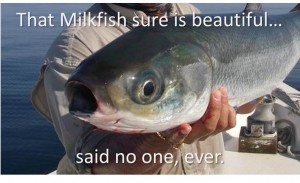
This is just how I feel.

It has to be said.
The tail of a permit.
The flank of a bonefish.
The head of an asian carp.

This is just how I feel.
OK… I think I know what we are going to do to give away the Cliff’s Crab Shack box that Cliff Outdoors gave me. First, I need to fill it with flies. My target # is 24. I’ll update over the coming weeks to show you how the box is coming along.
Once it is all filled and ready for you to go catch some fish I’ll put up a new post with the completed box and you will need to comment with one thing that happened on a fishing trip (preferably bonefishing, but it doesn’t have to be). Just one random thing. Anything. Sticking to random, I’ll choose a random winner and send this box off to them.
So, in the immortal words of Eric Cantona, “Watch this space.”
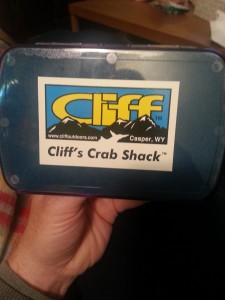
This is where the flies go.
I love it when content that is awesome shows up unnanounced in my in-box. That’s what happened on this guest post from Tom Paulson who picked up on my semi-fixation with someday cathing a GT. Here is his advice and experience chasing GT’s in Christmas Island. He had not fished for them before, so this is from a GT-Virgin perspective, which is how most of you (and I) would approach it. Good stuff.
—
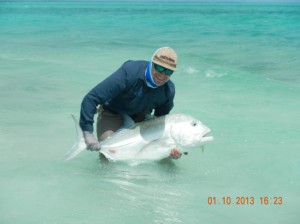
Nice fish. I want one.
I recently spent 6 days fly fishing in Christmas Island, Kiribati. This was my first trip to Christmas Island (CXI). I booked my trip 5 months ahead of time, and spent a lot of that time meticulously planning and learning all I could about the fishery at CXI and the gear necessary to battle the legendary Giant Trevally. I found it difficult to find any real detailed information about gear and setups, so this is my attempt to make a one stop shop for anyone heading to fish for GT’s for the first time. I’m writing this from the perspective of someone who had absolutely no experience with GT’s before this trip. Believe me, I know how overwhelming it can seem.
Most places you’ll fish for GT’s are far enough away from civilization, you want to make sure you’ve got your setups and back-ups spot on because once you get there, what you have is what you have. Having the necessary amount of back up equipment is essential, mark my words, these fish are hard on gear. You don’t want to be resigned to watching massive v-wakes come straight at you on the edge of the bonefish flat and have to think ‘gosh, I wish I would have brought back up Trevally stuff’. I also understand that fly-fishing for GT’s is a relatively new thing, my setup may not be the best, but for the most part, it worked for me. This is basically a reflection of what I learned fishing for GT’s.
My group fished the new moon spring tide. I was told before the trip that this was a favorable tide to encounter GT’s on the flats. We had plenty of shots for sure. I can’t speak for everyone in my party, but I would say I had roughly 10-15 shots at large Trevally from the flat. It seemed like every time we met back on the boat and exchanged experiences, someone had seen or had a good shot at a GT. (We also had plenty of success bonefishing this tide. People who go to CXI for bonefishing strictly I think often prefer to fish the neap tide, with the exception of the full moon Paris Flat phenomenon, but we never encountered a lack of bones from my perspective.)
We experienced the GT’s mostly cruising the edge of the flat as the tide was moving. They’ll be looking to ambush fish coming on, or leaving the flats. Most of the time you’ll be bonefishing and see their wake, or a large shadow approaching. It’s important to keep your cool, but to be quick. You’ll want to have your idle GT rod’s drag set so you can strip out enough line for a 30-50ft. and cast ASAP to get the best angle you can on the fish. The key is to get that fly roughly within a 10ft. window in front of that cruising fish. If that shows interest start stripping like there’s no tomorrow until you get a take, these fish love to chase. If the fish doesn’t show interest, and doesn’t spook, wait a little while to see if the fish returns. I noticed a few times that GT’s would circle around the same area 2-3 times before moving on.
One thing that surprised me on CXI was how selective a solo GT can be when they are in cruise mode. All the videos you’ll see of GT’s is mostly of groups of them going gangbusters after flies. My experience was that they can actually be quite picky. My perception before my trip was that these fish will take just about anything put in front of them, but that just isn’t the case in most situations. I think you’ll have the most success keying in on patterns that emulate milkfish, mullet, and yellow snapper in 3/0-6/0 (at CXI).
If you encounter a group however, you’ve got a much better shot of hooking up. In this situation, you could probably cast a boat anchor in front of them and probably get a take. The competition aspect increases their aggressiveness tenfold. It’s really something to see alternating mouths trying to engulf your fly while stripping like a mad man, trying not to wet your pants and wondering whether you’ll get a take before the fly hits the tip of your rod.
Everything anyone tells you about GT’s fighting dirty is probably true. It’s a lot different from a long drawn out tarpon fight. The fight isn’t a long one, but it is fast, furious, and nerve wracking. My group as a total for the week was 8/12 (GT’s hooked/GT’s landed). The four lost fish were due to 2 straightened hooks, 1 cut fly line, 1 cut spectra backing (lost fly line). The bottom line about fighting GT’s is, you have to get them turned as soon as possible. Once you hook these fish, you’ll want to lock your drag to the max setting. The further GT’s run the better their opportunity to run the entire capacity of your reel. Also, the further they run, the greater the opportunity they’ll have to find something to wrap you up on. Trust me, these fish will look for any and every opportunity to rub up on or wrap you around a coral head, and if they do it enough, they will break you off. I could feel one fish wrap me 5-6 times before I was finally able to get it free and land it. It’s a strange sensation of nausea and relief when you hear your line come free from a coral head.
Here is the strategy that worked best for me to get these fish landed:
Once you feel the fish, get a solid strip set. Check your line and make sure you’re going to be able to clear it without wrapping it on your reel seat. Also make sure it isn’t wrapped around you or any of your gear, and if it is, get ready to do a frantic “Trevally Dance” and hope for the best. Once hooked up, lock your drag down to the max setting. Aim your rod relatively horizontally just above your belt buckle, you want to let the reel do all the work. Any time you feel the fish give you any leeway pump and reel. You will feel these fish start to stall and take little mini runs, they are looking for something to hang you up on. Change your rod angle and start to pump and reel again. Once you’ve got them turned, you probably don’t have to worry about them running your capacity, so take your time and be methodical. If you feel that the fish has got you hung on a coral head, change rod angles, if that doesn’t work, lift your rod (while keeping it somewhat horizontal), if that doesn’t work walk towards or in the direction of your line (if possible) while repeating the steps above. If all else fails, get in a boat. Take care once you get the fish near the flat to keep the fish, and your line away from any obstructions. Keep the GT near the water, take a quick photo and make sure the fish is recovered and released appropriately.
My setup was as follows:
12 WT. TFO TiCR-x
I think the rod is probably the least important aspect of your setup, so if you’re looking for a way to save money, in my opinion the rod is the one. For the most part, you’re not going to need to make a cast over 50ft. Nevertheless, the TiCR-x did everything I needed it to.
Cheeky Thrash 475
I took a massive risk taking two of these reels to CXI seeing that they are relatively new product and untested. Everyone told me before I left ‘only the absolute best saltwater reels will do for Trevally’. But it’s hard to pass up being able to buy 2 of these reels for the price of 1 reel from one of the Tibor, Nautilus, Hatch variety. Whatever your premonitions are about this company, let me tell you, their reels are legit. I have had a reel from another company who people perceive to be one of the pinnacles of Saltwater reel manufacturers blow up on a ~125-150# tarpon. A GT in the 50# class will run further, fight harder, and dirtier than most Tarpon in my opinion. Your reel needs to be able to handle nearly its entire capacity being ran at max tension.
(I brought backups of each)
My reels were loaded as follows:
Base of 50-75 Yards 30# Dacron
The purpose of the Dacron is to provide a kind of cushion for the spectra. You’ll be fighting these GT’s @ your max drag setting so there is an incredible amount of tension. It was brought to my attention by a “GT veteran” that straight spectra will dig into itself and can cause you problems when the fish is running.
Doubled Bimini to Doubled Bimini
(the doubled Bimini is basically a Bimini with two loops instead of 1)
~250 Yards of 80# Spectra
(The spectra is used for the majority of your backing material as it is much more abrasion resistant than Dacron and also thinner, so you can increase your reel capacity, trust me, you’ll need it.)
Doubled Bimini to Welded Loop
Welded loop reinforced with 2 nail knots with 16# mono or flouro.
(UV knot glue applied to each connection above)
Airflo 50# core floating GT line.
Welded loop to Perfection Loop.
Note: I didn’t reinforce this welded loop, but I never had any trouble with just the loop to loop connection on its own.
~6 ft. Straight 100# fluorocarbon.
Lefty’s non-slip loop to fly.
After my experience at CXI, GT’s for me are the ultimate inshore species. Seeing a 50# GT chase down your fly is the thrill of a lifetime. These fish will test your gear, as well as your heart function. If you are even thinking of knocking out GT’s on your species list, do it. Now.
I must say in closing, I’ve been to many places fly fishing. For me, it’s such a thrill to fish new destinations that I rarely feel like I’d want to return to places I’ve been before. CXI is a place I would absolutely return to. There aren’t many other places you can target so many species in one place. Another draw for CXI is that you could probably spend 2 months fishing everyday in the lagoon and not fish the same flat twice. Lastly, you’ll never meet such caring, friendly people, smiling people as you will on CXI. It’s really uplifting to meet people with such amazing outlooks on life, who have practically no material possessions.
Tight lines and Cheers!
How Andrew at Deneki keeps coming up with stuff to write is amazing. He does it every day, several times and about three different fisheries and multiple species.
This latest bit has three random tips for bonefishing.
One of those tips has to do with lens wipes. Certainly something to consider. I’ve carried a bag with a little TP in it to wipe lenses with and that doesn’t seem to do the job very well at times. I’ve tried a micro-cloth and once that gets a little wet (as sometimes happens), it is toast.
Andrew has a suggestion for a fix, but I’m curious how you all deal with cleaning your lenses while out on the flats.
Gotta keep ’em clean.
I almost forgot about Science Wednesday. By that, I mean to say I totally forgot about Science Wednesday, but I figure slightly delayed is still pretty good.
So… let’s talk about what happens to those C&R bonefish. It turns out they stink. They stink no so you or I would notice, but if you were say, a Negaprion brevirostris, you would likely take notice. That’s a lemon shark and while you might like lemon with your fish, it turns out that the lemon has a bit of a taste for fish as well. In this case, it is stinky bonefish they are partial to.
You catch a fish, the fish gets stressed and it releases some chemicals. I had thought that chemical was cortisol, but it turns out that particular chemical is too weak to detect. The ammonia and urea, on the other hand are put out there in quantities that scream “Here I am, come eat me!”
This is why bonefish handling is so important. You need to minimize the fight time and air exposure so that fish is capable of doing what it needs to do when it gets release, which is going really fast to get away from young lemon sharks who are attracted to the chemical neon sign that fish is putting out reading “Bonefish, all you can eat (supplies limited).”
One of the authors of this study is Andy Danylchuk.
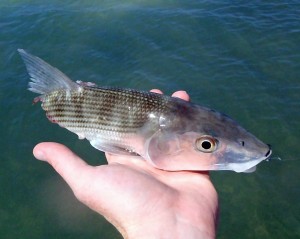
Thanks for the pull. Sorry it didn’t work out.
Because I’m lazy today… and I’m off to the Wine Train with the lovely wife.
(not excellent handling here)
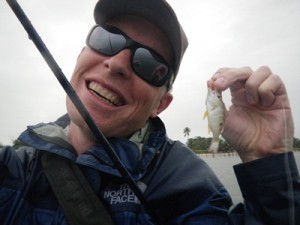
Fishing is good.
I was reflecting recently on the label I sometimes am given… that of “expert.” I’m not. I try to be pretty clear about that. I am just profoundly interested in the subject, which does not make me an expert anymore than being a die-hard fan of American Idol would make someone a singer. I thought I’d list the reasons why I’m not an expert, just so everyone is on the same page.
1. Any bonefishing guide knows 100x more than what I know. When you are on the water a lot, and I mean daily/weekly, you have an understanding of a species, a place, a mindset that cannot be replicated by those who are not there. I saw this even on my own rivers in Nor Cal. I only guided a single season on the trout streams of Northern California, but for that season I had the pulse of my rivers. I knew what was happening and what was about to happen. I had fish that I knew I could count on.
I don’t have the pulse of any flat. I don’t have a handle on the tides anywhere. I don’t know where the fish are going to be. Simple as that.
2. I’m not a FFF certified casting instructor. I have not won a shootout of any kind or even entered a distance casting competition. I have personally fished with several people who could out cast me pretty much any day of the week and twice on Sunday. My casting has improved a lot since I started chasing bonefish. A lot. I still have some rough edges.
3. I’m not an outfitter. I have heard about a lot of places and almost every single one of those places is a place I have not been myself. People ask me about flats in Abaco or Exuma or Honolulu or Placencia or wherever and every single one of those places I could find on a map and tell you there are fish there and the conversation would pretty much stop there. I have no experiences to share from those places because I have not fished them. I know of them. I do not know them.
There are a lot of experts out there. I know some of them and I look to learn from others. Every trip has something to teach, most anglers have something to share. That’s why I like this whole blog thing.
Great post over at Deneki about things that bonefish hate… like noise.
There certainly are things you can do to minimize your chances of hooking up and maximizing your chances of witnessing how fast an unencumbered bonefish can race off the flat you are fishing.
The sound thing is interesting because it is certainly very, very true right up to the point where it isn’t.
You slam the cooler lid? That sucks… that is going to scare the fish away pretty well. That’s been documented well.
On the other hand, I was out fishing with a guy who has caught more permit than I’m likely to even catch bonefish and he was blaring his tunes right there on the boat on the flat while we searched for fish. We found fish. We caught fish. All the while there were tunes being cranked out.
Certainly that IS noise and not the natural kind and not the kind a bonefish, you’d think, would be totally down with.
Check out the post at Deneki and comment there to add to the list of things bonefish hate. If you have a comment on the whole music blaring, I’d love to hear about it here.
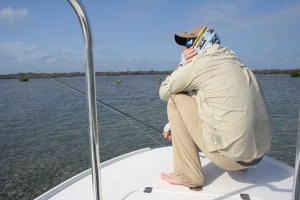
Photo by Matt Hansen.
I was reminded by Troutrageous that it was time for me to look back at 2012.
What a year, eh? I had highlights in my personal and fishing lives. It will be a hard year to surpass, really. So many wonderful things happened. I can’t help but feel like a very lucky guy.
Here is what 2012 held for me.
I welcomed 2012 in at the Yaak Tavern in MT where I had the very strong suspicion I had met my future wife.
I got a chance to go to Cuba with Jim Klug and a bunch of writers. Amazing experience that included my magazine worthy Tarpon shot.

Photo by Jim Klug, Tarpon by Cuba
My divorce got finalized.
I got engaged.
I discovered the joys of pier fishing with my girl who loves sharks and loves being my fishing buddy.
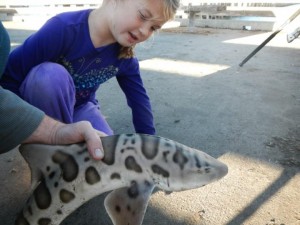
The girl and her shark.
I got married.

A good day.
The honeymoon brought me back to El Pescador in Belize.

I got two saltwater trips in, which for me, being fully employed and having split custody of a 5 year old, is a pretty good trick. Cuba and Belize are kind of choice locations and I feel very fortunate to have been able to visit both in 2012.
It has been a very, very good year. I’m looking forward to what 2013 will bring.
I have one trip lined up already. This is to Grand Bahama for Spring Break. It will be my intro to the Bahamas for my little girl and my new wife. I’m thinking this could be a good thing.
All the best to you in 2013 and thanks for reading and taking part in the blog.